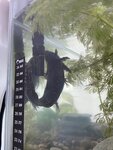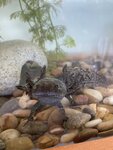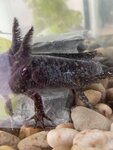sianie.b
New member
Hi, hoping someone can help me determine what is the cause of my axolotls slime coat peeling off.
To give some background, I have had it for about 2-3 weeks (“it” is still nameless as we are unsure of the gender but I call it a “he” out of habit). I have been doing 20% water changes about weekly since we’ve had it, and yes I use dechlorinated water.
but I call it a “he” out of habit). I have been doing 20% water changes about weekly since we’ve had it, and yes I use dechlorinated water.
I treated him last week for a fungal infection when I noticed him starting to get white ‘fuzz’ on his head and acting sluggish and just really sickly in general. I did 1 salt bath per day for a few days, even tho it was visibly gone after just 1.
Anyway, I changed the water on Monday and when I went to do this, I thought I saw the fungus coming back, so I gave him a salt bath again (much to his disgust as he fought me a lot on being in there compared to previous times), did my 20% water change, then returned him to the tank. The next day (Tuesday) I thought I saw the fungus still there, but as the day went on, I realised it was actually his slime coat peeling off. And today (Thursday) it is even worse.
The water temp is always around 16-18 degreesC. I tested the water parameters on the Tuesday (listed below) and everything seems ok to me based on what I’ve read. He has not lost his appetite at all, in fact he seems a little extra hungry, and is still moving around the tank a usual amount. I don’t think the water flow is stressing him as he seems to be quite happy sitting under the filter and even swims up to it (see pictures).
Considering on all other accounts he seems happy, I am guessing it is just the stress of the last salt bath that has caused the peeling?
Hopefully someone can shed some insight so I can stop stressing
water parameters:
PH - 7.6 (high range PH test said 7.4, not sure what the difference is)
Ammonia - 0.25ppm
Nitrite - 0ppm
Nitrate - 0ppm
The tank is approx 54L (14.27 U.S Gallons)
To give some background, I have had it for about 2-3 weeks (“it” is still nameless as we are unsure of the gender
I treated him last week for a fungal infection when I noticed him starting to get white ‘fuzz’ on his head and acting sluggish and just really sickly in general. I did 1 salt bath per day for a few days, even tho it was visibly gone after just 1.
Anyway, I changed the water on Monday and when I went to do this, I thought I saw the fungus coming back, so I gave him a salt bath again (much to his disgust as he fought me a lot on being in there compared to previous times), did my 20% water change, then returned him to the tank. The next day (Tuesday) I thought I saw the fungus still there, but as the day went on, I realised it was actually his slime coat peeling off. And today (Thursday) it is even worse.
The water temp is always around 16-18 degreesC. I tested the water parameters on the Tuesday (listed below) and everything seems ok to me based on what I’ve read. He has not lost his appetite at all, in fact he seems a little extra hungry, and is still moving around the tank a usual amount. I don’t think the water flow is stressing him as he seems to be quite happy sitting under the filter and even swims up to it (see pictures).
Considering on all other accounts he seems happy, I am guessing it is just the stress of the last salt bath that has caused the peeling?
Hopefully someone can shed some insight so I can stop stressing
water parameters:
PH - 7.6 (high range PH test said 7.4, not sure what the difference is)
Ammonia - 0.25ppm
Nitrite - 0ppm
Nitrate - 0ppm
The tank is approx 54L (14.27 U.S Gallons)
Attachments
-
 0A4F2702-4EB8-4C79-B4B8-C422703189A0.jpeg1.5 MB · Views: 439
0A4F2702-4EB8-4C79-B4B8-C422703189A0.jpeg1.5 MB · Views: 439 -
 9E1EA553-BC8C-4A04-A748-DE44FFED2404.jpeg1.6 MB · Views: 233
9E1EA553-BC8C-4A04-A748-DE44FFED2404.jpeg1.6 MB · Views: 233 -
 EC775459-C157-4268-842E-99030D918343.jpeg1.3 MB · Views: 183
EC775459-C157-4268-842E-99030D918343.jpeg1.3 MB · Views: 183 -
 9F897349-D2D8-44E0-B93F-5F8155443AF1.jpeg1.6 MB · Views: 230
9F897349-D2D8-44E0-B93F-5F8155443AF1.jpeg1.6 MB · Views: 230 -
 7E63D14E-05F6-46F2-8050-1234B90D4EB1.jpeg1.6 MB · Views: 235
7E63D14E-05F6-46F2-8050-1234B90D4EB1.jpeg1.6 MB · Views: 235
Last edited:
